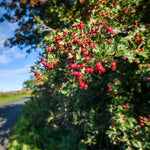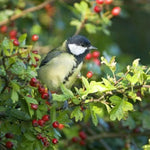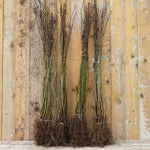 Delivered across the UK
Delivered across the UK Which Best Plant Supplier 2025
Which Best Plant Supplier 2025 1 Year Bareroot Plant Guarantee
1 Year Bareroot Plant Guarantee
About This Product
Hawthorn Hedge Plants
Hawthorn, known as quickthorn or whitethorn in some parts, grows into a pretty and impenetrable hedge in a hurry. Unlike many hedge plants, it's blessed with three seasons of interest. Spring boasts a froth of simple, white slightly scented flowers that stand out against the blackness of the wood. Summer is a mass of healthy, dark green, lobed leaves, and then autumn sees astonishingly red haws. In winter, the spiny silhouettes of the black branches look spectacular on a frosty day. It's extremely tough and easy to grow.
Features
- Sold as Bareroot whips and older plants ranging in size from 40-120 cm
- Final hedge height: 1 - 6m
- Soil: Just about any, except fully waterlogged or pure sand.
- Use: Stockproof, vandal proof, informal and farm hedging
- Single Row: plant at 3 per metre.
- Double row: plant at 6 per metre in a zig zag
- Colour: mid green leaves with white flowers and red haws
- Very tough, disease resistant and thorny
Growing Hawthorn Hedges
It's easier to ask: where won't Hawthorn grow?
It won't grow at water level in a swamp like willow or dogwood, or in pure sand on the beach like tamarisk and rugosa roses, and it'll grow slowly in full shade compared to wild privet or hazel.
With that said, we have seen wizened old hawthorns growing:
Features
- on a small raised mound in the middle of a bog less than one metre above the water
- on poor, sandy soil just behind a beach with no cover from the salt winds,
- in between buildings on industrial estates where it probably got three hours of sun in midsummer at most.
Spacing a Hawthorn hedge:
Standard country hedging: plant at 3 per metre, 33cm apart in a single row, or 6 per metre in a staggered double row, which has a W shape viewed top-down.
Garden Design Ideas
Hawthorn's charm is its informality and its virtue is its resilience. Once established, you will have a thick, wiry hedge that no intruder would care to breach. For this purpose, it's fine on its own, but for the most pleasing and natural look, it should be mixed up with your favourite country hedge plants, which you can design yourself or buy ready to go in our six-species mixed conservation hedging packs (these include Britain's most beautiful wild shrub, the Guelder Rose, Viburnum opulus).
It's a top choice as a specimen tree (ideal for small gardens) in particularly exposed, windy or coastal conditions, where it typically takes on a sculptural, gnarled shape that looks fantastic in winter, and we recommend the more ornamental Hawthorn varieties for this purpose.
History & Trivia
Over 150 insects will call your hawthorn home, from the bumblebee, lacewing, ladybird and earwig to the hawthorn shield bug, all of which provide valuable food for blue tits, wrens and garden spiders. Greenfinches, chaffinches, yellowhammers, fieldfares and many more birds feast on the haws in the autumn and many, like the wren and blackbird, will nest there too: slow worms and toads love a nice, wide country hedge as well.
Crataegus monogyna is a true native plant and, because it is so widespread and so useful, it has a plethora of local names: Haw, Hawthorne, Quickthorn, Whitethorn, Maythorn, Mayblossom, and May Tree. In country hedge jargon, the abbreviation "thorn" usually refers to Hawthorn.
Hawthorn is literally synonymous with hedging: Haw, which also refers to the fruit, is derived from the Old English word for hedge. The blossom is known as May, as in "Rough winds do shake the darling buds of May, and summer's lease hath all too short a date" or "Ne'er cast a clout till May be out", which means that one should not start leaving ones warm winter clothes (clouts) at home until the hawthorn is flowering. The nursery rhyme "Here we come gathering nuts in May" is probably a corruption of "knots of May", meaning bouquets of hawthorn blossom (there are no nuts to harvest in Spring).
It was probably a hawthorn hedge through which the handsome prince had to hack his way to reach Sleeping Beauty.










 Secure, One-Tap Checkout
Secure, One-Tap Checkout
 Hand Picked, Delivered to Your Door!
Hand Picked, Delivered to Your Door! 1 Year Bareroot Guarantee
1 Year Bareroot Guarantee





















